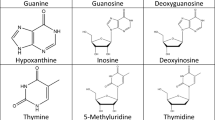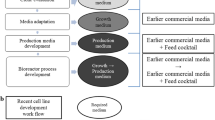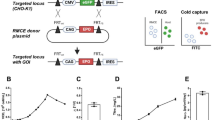Abstract
Since the recombinant thyroid-stimulating hormone (rhTSH) is secreted by stably transfected Chinese hamster ovary (CHO-hTSH) cells, a bioprocess consisting of immobilizing the cells on a substrate allowing their multiplication is very suitable for rhTSH recovering from supernatants at relative high degree of purity. In addition, such a system has also the advantage of easily allowing delicate manipulations of culture medium replacement. In the present study, we show the development of a laboratory scale bioprocess protocol of CHO-hTSH cell cultures on cytodex microcarriers (MCs) in a 1 L bioreactor, for the preparation of rhTSH batches in view of structure/function studies. CHO-hTSH cells were cultivated on a fetal bovine serum supplemented medium during cell growth phase. For rhTSH synthesis phase, 75% of supernatant was replaced by animal protein-free medium every 24 h. Cell cultures were monitored for agitation (rpm), temperature (°C), dissolved oxygen (% DO), pH, cell concentration, MCs coverage, glucose consumption, lactate production, and rhTSH expression. The results indicate that the amount of MCs in the culture and the cell concentration at the beginning of rhTSH synthesis phase were crucial parameters for improving the final rhTSH production. By cultivating the CHO-hTSH cells with an initial cell seeding of four cells/MC on 4 g/L of MCs with a repeated fed batch mode of operation at 40 rpm, 37 °C, 20% DO, and pH 7.2 and starting the rhTSH synthesis phase with 3 × 106 cells/mL, we were able to supply the cultures with enough glucose, to maintain low levels of lactate, and to provide high percent (∼80%) of fully covered MCs for a long period (5 days) and attain a high cell concentration (∼9 × 105 cells/mL). The novelty of the present study is represented by the establishment of cell culture conditions allowing us to produce ∼1.6 mg/L of rhTSH in an already suitable degree of purity. Batches of produced rhTSH were purified and showed biological activity.



Similar content being viewed by others
Abbreviations
- rhTSH:
-
Recombinant thyroid-stimulating hormone
- CHO:
-
Chinese hamster ovary
- MCs:
-
Cytodex microcarriers
- DO:
-
Dissolved oxygen
References
Amoresano, A., Siciliano, R., Orru, S., Napoleoni, R., Altarocca, V., DeLuca, E., et al. (1996). European Journal of Biochemistry, 242, 608–618.
Carvalho, C. M., Oliveira, J. E., Almeida, B. E., Ueda, E. K. M., Torjesen, P. A., Bartolini, P., et al. (2009). Journal of Chromatography A, 1216, 1431–1438.
Robbins, R. J., Tuttle, R. M., Sharaf, R. N., Larson, S. M., Robbins, H. K., Ghossein, R. A., et al. (2001). The Journal of Clinical Endocrinology and Metabolism, 86, 619–625.
Peroni, C. N., Soares, C. R. J., Gimbo, E., Morganti, L., Ribela, M. T. C. P., & Bartolini, P. (2002). Biotechnology and Applied Biochemistry, 35, 19–26.
Kohlfuerst, S., Igerc, I., & Lind, P. (2005). Thyroid, 15, 371–376.
Luster, M. (2006). Acta Oncológica, 45, 1018–1030.
Szkudlinski, M. W., Fremont, V., Ronin, C., & Weintraub, B. D. (2002). Physiological Reviews, 82, 473–502.
Emerson, C. H., & Torres, M. S. T. (2003). Biodrugs, 17, 19–38.
Cole, E. S., Lee, K., Lauziere, K., Kelton, C., Chappel, S., Weintraub, B., et al. (1993). Bio technology, 11, 1014–1024.
Damiani, R., Oliveira, J. E., Vorauer-Uhl, K., Peroni, C. N., Vianna, E. G., Bartolini, P., et al. (2009). Protein Expression and Purification, 67, 7–14.
Chotigeat, W., Watanapokasin, Y., Mahler, S., & Gray, P. P. (1994). Cytotechnology, 15, 217–221.
Watson, E., Shah, B., Leiderman, L., Hsu, Y. R., Karkare, S., Lu, H. S., et al. (1994). Biotechnology Progress, 10, 39–44.
Mohan, C., Kim, Y., Koo, J., & Lee, G. M. (2008). Biotechnology Journal, 3, 624–630.
Nam, J. H., Ermonval, M., & Sharfstein, S. T. (2009). Cytotechnology, 59, 81–91.
Nam, J. H., Ermonval, M., & Sharfstein, S. T. (2007). Biotechnology Progress, 23, 652–660.
Ribela, M. T. C. P., Bianco, A. C., & Bartolini, P. (1996). The Journal of Clinical Endocrinology and Metabolism, 81, 249–256.
Peroni, C. N., Ribela, M. T. C. P., & Bartolini, P. (1997). Journal of Immunoassay, 18, 247–265.
Oliveira, J. E., Damiani, R., Bartolini, P., & Ribela, M. T. C. P. (2007). Journal of Chromatography A, 1164, 206–211.
Oliveira, J. E., Damiani, R., Vorauer-Uhl, K., Bartolini, P., & Ribela, M. T. C. P. (2008). Molecular Biotechnology, 39, 159–166.
Goochee, C. F., Gramer, M. J., Andersen, D. C., Bahr, J. B., & Rasmussen, J. R. (1991). Biotechnology, 9, 1347–1355.
Jenkins, N., & Curling, E. M. A. (1994). Enzyme and Microbial Technology, 16, 354–364.
Acknowledgements
This work was supported in part by grants from the FAPESP (05/60826-3; 02/09482-3), CNPq and Fundação Butantan. Carlos A Pereira is recipient of CNPq 1A research fellowship. Daniella C Ventini and Alvaro PB Souza had scholarships from FAPESP (07/52264-0, 06/57794-5).
Author information
Authors and Affiliations
Corresponding author
Rights and permissions
About this article
Cite this article
Ventini, D.C., Damiani, R., Sousa, A.P.B. et al. Improved Bioprocess with CHO-hTSH Cells on Higher Microcarrier Concentration Provides Higher Overall Biomass and Productivity for rhTSH. Appl Biochem Biotechnol 164, 401–409 (2011). https://doi.org/10.1007/s12010-010-9143-5
Received:
Accepted:
Published:
Issue Date:
DOI: https://doi.org/10.1007/s12010-010-9143-5




